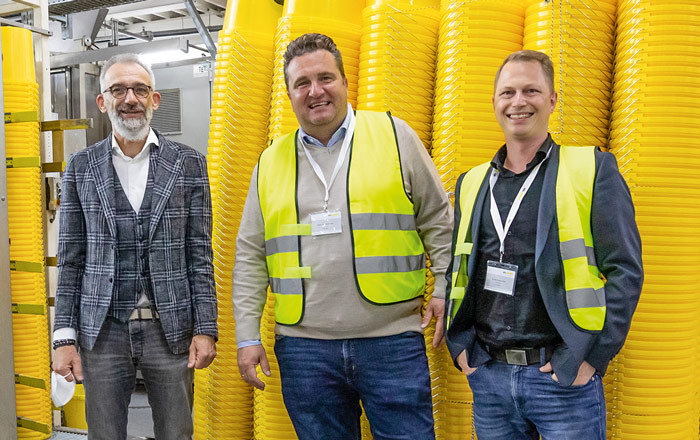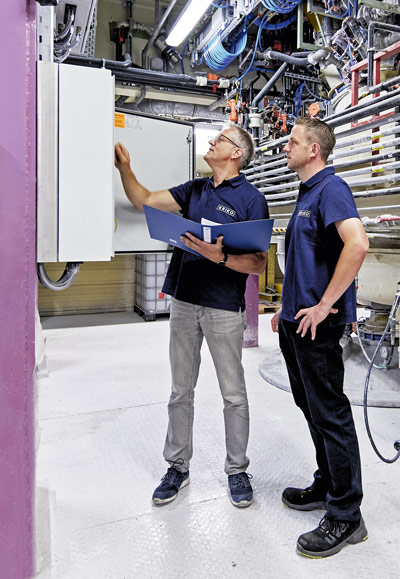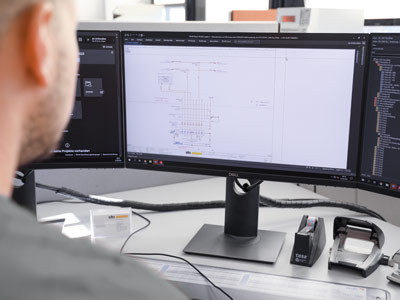Text Marius Schaub ––– Photography
Production 3” is the facility in Stühlingen at the Sto headquarters that is responsible for the biggest proportion of the total output produced by this manufacturer of paints, varnishes, and coating and heat insulation systems. The facility has been operational since 1980, but problems have built up over the years. For example, it has become more difficult to get hold of spare parts for measurement and control technology components.
The growing product portfolio also meant the facility was facing more and more challenges. “Whenever a new product was developed and brought to the market, we had to create space in our tank storage facility for new raw materials, increase capacity or lay new pipes,” explains Joachim Hauschel, who is in charge of planning and automating systems with Eplan at Sto in Stühlingen. The ever-increasing scale of the process engineering involved meant that process control reached its limits. Ultimately, the result was that there were no longer any free interfaces available, since all of them were already in use.
The issue of media discontinuity
There was nothing else for it – an expansion was absolutely essential to bring the production capacity and automation up to date. Hauschel and his colleagues in the planning and automation team wanted to solve another problem, too: “We had already used Eplan to digitally configure the system’s existing electrical design engineering. However, the entire piping and instrumentation flow chart existed only on paper or in Excel charts – and even that documentation was very sparse, because it was never updated when changes were made.”
”The plant staff always felt the effects of this as soon as maintenance work or process modifications were called for – in many cases, staff had to trace the relevant pipes by physically walking through the plant. It was laborious work. “There were some pipelines I followed five times on foot – getting a different result each time. After all, it’s really easy to miss a branching off,” Hauschel explains.
To create a totally reliable database, make work easier for his own staff and provide the control system engineer carrying out the retrofit with a complete picture of both the target and actual state of production, Hauschel included not only the electrical design engineering in the specifications, but the fully digital piping and instrumentation (P&I) flow chart, too. “To do this, we were looking for a standardised platform that would offer us everything from a single source,” Hauschel explains. The search produced exactly what they were looking for – the Eplan platform. This was the ideal solution, as it offered a state-of-the-art technical basis for cutting-edge engineering that would make it possible to digitalize all areas of the industry.
Eplan Electric P8, which is used to create circuit plans and wiring schematics, also automatically generates detailed evaluations as an integral component of the project documentation. Meanwhile, Eplan Preplanning means that engineering data can be collected digitally across all planning phases – from electrical engineering, fluid technology and P&I through to electrical measurement and control technology – and prepared in such a way that it can also be used for operation and maintenance.
“Although we’d heard of Eplan Preplanning, we weren’t familiar with the functions and features the system offers,” Hauschel recalls. The Sto managers inspected a reference system to get better acquainted with the tool, but it was a service provider that Hauschel knew from earlier projects that tipped the scale – Kaltschmid Industrial Engineering. This electrical engineering company uses Eplan for all its engineering processes. The company’s Managing Director, Ronny Kaltschmid, explains why: “Preplanning lets you record engineering data early in the preplanning process – and this proved ideal for the Sto project.”
Interconnected at last
The integrated functionality helped keep the project on its tight schedule. “We needed to complete the instrumentation flow chart in just three months, so that our automation specialist, KRIKO Engineering in Merzhausen, could then get started on its work,” says Hauschel. Even so, Kaltschmid recommended including fluid technology as a third discipline, since all shut-off valves in the Sto production facility are controlled by pneumatic actuators. “Electrical planning that also incorporates fluid planning in the documentation hugely simplifies the processes in both engineering and everyday production,” Kaltschmid explains. Hauschel shares this view.
Following an analysis of various suppliers, the job of planning and implementing the entire retrofit was awarded to KRIKO Engineering GmbH, an automation and drive specialist with extensive expertise in Eplan, control technology, process control and IT. Thanks to the development of efficient macros and the integrated functionality of Eplan with Preplanning and Fluid, the upgraded system was able to start regular operation just nine months later, in January 2020. “Even during the planning phase, we carried out renovations with KRIKO to ensure a quick switch-over to the new production control system, because we knew we only had two weeks available for the switch,” comments Hauschel.
Due to just-in-time production, the system engineering team needs to be able to guarantee system availability of 98.5per cent at all times. This availability is ensured by means of a 24/7 on-call service. If there is a problem in part of the system, a member of the team needs to be on site within 30 minutes to get production going again as quickly as possible. “That’s why we need to have documentation that is up to date at all times,” emphasises Hauschel.
In extreme circumstances, this means that, even at 3 a.m., the plan needs to show very clearly where each component is installed and how they are all connected. “Eplan meets this requirement perfectly,” Hauschel reports. The tools help visualise projects and make them easier to understand. “For us, one of the biggest advantages of this trio – Eplan Preplanning, Electric P8 and Fluid – is that we can now undertake all plans and modifications ourselves,” Hauschel sums up after the retrofit.
Twice as fast
For the planning and automation managers at Sto, a really important criterion is that staff need to be able to work independently during everyday operations. This criterion also applies in relation to the Rittal enclosures that are standard components at Sto. “When it comes to these components, which are so crucial, our philosophy is that every apprentice must have built an enclosure themselves, at least once. This is the only way they’ll gain an understanding of what it means to saw, drill, cut a thread and do the wiring.” Hauschel has consistently applied this principle not only in respect of the hardware, but the software, too. Each and every member of staff should be aware of the importance of reliable, centrally stored data.
The Eplan tools have been used for maintaining data right from the very start of the project. “Eplan exports all the data – wherever it is processed and whether it is in the form of text, equipment identifiers or other information – to other systems so that everything is synchronous at all times,” says Hauschel as he explains the procedure. Since changes are made to the process technology or production control on an everyday basis, he works with the tools daily: “Outlook, Teams, Eplan – the first thing I do when I sit down at my desk in the morning is to start up these programs, because I need them throughout my working day.”
So, was the decision to use Preplanning, Electric P8 and Fluid as a bundle the right one? Planning and automation expert Hauschel gives a factual answer: “We’re now making a time saving of at least 50 per cent. In the past, we often had to walk through the entire plant when problems arose. Now, we use the flow chart as our guide and this gives us a complete overview straight away.” The fact that pneumatic plans are an integral part of the full schematics also makes everyday work easier.
“The function for switching between the different disciplines is just great,” says Hauschel. “A basis for communication has also been created with the system,” adds Kaltschmid, pointing to the advantages that extend beyond production and the Sto staff, and explaining that suppliers, maintenance engineers and other service providers are now all benefiting from the central, integrated data storage system. Hauschel is quick to agree: “The reliable database has improved our efficiency both inwards and outwards. For example, if a service provider needs to perform maintenance work on part of the system, a PDF that has been produced in Eplan is sent to them in advance. This gives them a much more comprehensive picture than just a list of the installed components.”
There are more than 500 wiring schematics for the Sto systems in Eplan Electric P8. For three of the production systems in Stühlingen, the P&I diagrams have already been mapped out in Eplan Preplanning, while 50 up-to-date pneumatic diagrams have been documented with Eplan Fluid. “The system is growing all the time,” Hauschel says. He should know – he deals with changes and extensions on a daily basis. “It’s now impossible to imagine our everyday business without Eplan.”


